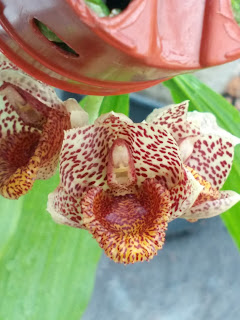


i purchase a few catasetums quite sometime ago, as usual they came in sphag moss media and also as usual, my practice is to remove them from the sphag media and repot them in my preferred media. however this practice this time paid off completely.
even after removal of the moss, then entire plant seems "ok" as there are new growths and some of the bulbs fat and solid, or at least they appears full of vigor. however upon closer inspection, i notice black spots on the bulbs and therefore i took the bold decision to cut them into individual bulbs!
the more i trimmed the bulbs apart, the more signs on bulb rot i found (you can see from the third pic how extensive the damages were). some only came in 2 bulbs and the size of the bulb are merely 2 inches (in the pic where i am holding them on my palm but sad to say one is already rotting away when they arrived).
2 months after separating them, at least one from each type of the catasetums had started new growth except for one, and i only came down with 2 bulb that is totally lost, started to have duplicates of them due to the division. with some drastic measure, some are cut what ever is left is the undeveloped lead bulbs and happy to say, new roots started to emerge a few days ago (first pic).
if i were to left them in the moss or without doing further inspection , most likely i would end up losing half of them. thus i would say it is a small price to pay for in assuring their survival. sometimes small sacrifices are necessary when one are fighting a war, as the Witwicky said it "no sacrifice no victory".
and hopefully in times, the sixth catasetums in this batch would show new growth, and hopefully in time i would have the chance to publish their graceful and showy inflorescence.
but for the mean time, let us not forget that this does not means the end of this "war", but only the beginning as there are still many challenges ahead.














 the subsequent picture is the new lead bulb is optimal growth phase, most of the catasetums begins to flower at this phase. here you can see that the normal fat pseudobulb shape has not taken place yet and during this phase, they grow very fast and hence they require heavy watering and feeding.
the subsequent picture is the new lead bulb is optimal growth phase, most of the catasetums begins to flower at this phase. here you can see that the normal fat pseudobulb shape has not taken place yet and during this phase, they grow very fast and hence they require heavy watering and feeding.
 covering the bulb. by time these sheaths will fully enveloped the entire bulb.
covering the bulb. by time these sheaths will fully enveloped the entire bulb.





























